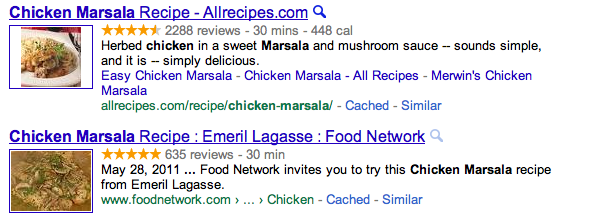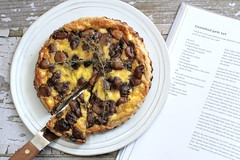the taste algorithm


A couple of months ago Julia Moskin’s blog post Google’s New Recipe Search brought to light the new algorithm Google implemented in February to seach for recipes. She said that these days people are more likely to look for recipes on Google rather than Food Network or the New York Times. The latest changes made by Google for their one billion recipe searches per month was to add to the left hand side of their results a column containing choices you can streamline your search by, such as ingredients, cook time and calories. Although at first glance these might seems helpful and creative, but Moskin points out, “..this means is that Google’s search engine gives vast advantage to the largest recipe websites with the resources to input all this metadata, and particularly those who home in on “quick and easy” and low calorie dishes (which, by the way, doesn’t mean the recipes are actually healthy). In so doing, Google unwittingly — but damagingly — promotes a cooking culture focused on speed and diets.”
She also goes on to say that the search results turn up recipes that don’t meet the criteria the user requested, but hidden somewhere in the metatag for the recipe was probably this false information which caused the recipe to show up on the Google’s first page.
WHAT GOOGLE PRODUCT MANAGER HAD TO SAY ABOUT THIS
Interestingly enough, her blog post was picked up by Kavi, a product manager on Google’s search quality team as well as David Lebovitz (and not to mention New York Times). Kavi wrote a detailed comment on the post stating that these new filters are used by very few people and most people scan down the list of unfiltered recipes. The ingredients filter gets the most usage from all the filters. Recipe quality is hard to gage by a ranking algorithm unless it has been recommended by other users. He agreed that food blogs are underrepresented in recipe view results.
He said, “Recipes on food blogs tend to be written differently than recipes on database-driven recipe sites. There’s often more discussion of the dish and the preparation, a greater focus on photos, and visitors to the blog leave comments rather than ratings or reviews. We need to adapt our markup formats to better fit the content that appears most frequently on blogs. We’ve already started to make some changes on this front. “
ADDING MICRODATA TO YOUR RECIPE
Google displays rich snippets when you search for a recipe. They look like these two examples below:

These rich snippets, which appear in search results can be added to your own post so it displays similarly.
I looked further into what is involved in making google recognize a blog post with a recipe as a searchable recipe and rich snippets. It seems that hidden microdata has to be added to the HTML of the post. For example where it says
Prep time: 30 minutes
It needs to say:
Prep time: <time itemprop="prepTime" datetime="PT30M"> 30 minutes </time>
A full explanation of all microdata HTML tags are given in this google article. The name of the recipe and at least two other properties need to be added to the post from the following list: photo, prepTime, cookTime, totalTime, ingredient, calories or review. After you have added these tags to your recipes Google provides a tool to check if the rich snippets appear correctly in a search result.
This is a lot of work but with some practice it can become part of your workflow.. just like photo processing. innBrooklyn has never used this before but I am intrigued to see how this can might change searaches that find us. If we implement this we will report the results back to you.
by Noerah








Wow. I just learned about RAW formats on photos. (I just learned about it, meaning, I still have SO much to learn about photography generally). I’m not even going to get to trying this now! I’ll be interested to read about your experiences though…
It’s just too much effort… thanks for the inside dope though… hopefully they will come up with a simple solution so that all may use it without an extra 1/2 hour doing the extra steps for recognition.
Agreed with Deana. I’m fascinated with technology, but do have that love/hate relationship with it. If microdata tags were ‘easy’ to insert (automatic on the blogging platform templates), I’d be most happy!
Okay, Noerah’s list of things to do next year..
1. Write a program for Rebecca and Deana in which custom recipe tags and be inserted automatically in posts, but first research if something like this already exists!
-Noerah